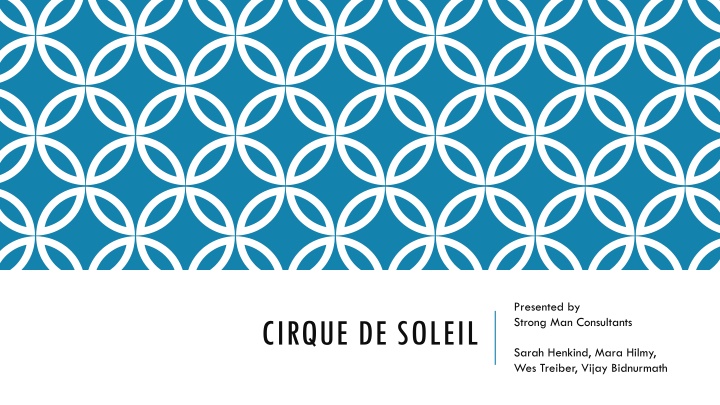Evolution of Circus Entertainment: Cirque de Soleil versus Traditional Circus
Delve into the evolution of circus entertainment with a comparison between Cirque de Soleil and traditional circus performances. Explore the history, customer profiles, industry reactions, competitive landscape, and recommendations for revamping the circus industry, highlighting the shift towards quality, exclusivity, and storytelling. Discover how the circus industry has transformed over time, impacting both performers and audience expectations.
Download Presentation

Please find below an Image/Link to download the presentation.
The content on the website is provided AS IS for your information and personal use only. It may not be sold, licensed, or shared on other websites without obtaining consent from the author.If you encounter any issues during the download, it is possible that the publisher has removed the file from their server.
You are allowed to download the files provided on this website for personal or commercial use, subject to the condition that they are used lawfully. All files are the property of their respective owners.
The content on the website is provided AS IS for your information and personal use only. It may not be sold, licensed, or shared on other websites without obtaining consent from the author.
E N D
Presentation Transcript
Presented by Strong Man Consultants CIRQUE DE SOLEIL Sarah Henkind, Mara Hilmy, Wes Treiber, Vijay Bidnurmath
AGENDA History of the Circus State of the Circus Alternatives Recommendations Questions
HISTORY OF THE CIRCUS Started as a Freak Show Bearded lady, strong man Clowns Trained animals Took advantage of these people Started travelling with them Generic circus moves
CIRQUE DE SOLEIL VERSUS THE CIRCUS Cirque de Soleil Variety of acts Exclusivity Focus on quality rather than quantity Story telling Traditional Circus Traveled city to city Similar acts Focus on volume of attendance Tricks versus artistry
COMPETITIVE LANDSCAPE Direct Indirect Movie theatres, traditional theatres Traditional circus acts like PT Barnum Local carnivals or state fairs Sports events, concerts
CUSTOMER PROFILE Parents looking for affordable entertainment for their children Have a nostalgic view of the circus Families Individual who want different and exciting experiences Looking to view life on the edge Thrill seekers Unique dating experience Alternatives to traditional entertainment Couples on dates
HOW DO PEOPLE SEE THE CIRCUS Cirque de Soleil Traditional Circus Quality Carnivals Price
INDUSTRY REACTION Circus expectations transformed Reactive- there was no competing with cirque de soleil. Many independent circuses were forced to shut down Only big names were able to survive
HOW TO REVAMP THE CIRCUS Focus on Seasonality: Pros Would offer fresh and exclusive reasons for people to attend Creates repeat customers for specific seasons Cons Circus would focus on creating demand by focusing on creating acts related to the seasonality and culture of the region they are performing in For example haunted houses during Halloween, romance focused experiences around valentines day, or Santa themed during Christmas Production costs Variability in predicting revenues
HOW TO REVAMP THE CIRCUS Pros Pivot to educational alternatives: No animal cruelty Could be booked with school or other educational entities Cons Caters back to the child or family customer target Would be based on STEM education principles such as large science experiments Not applicable to a wide variety of audiences Potential lack of variety
HOW TO REVAMP THE CIRCUS Bring in high profile entertainers: Pros Goal would be to bring in big name entertainers building off of their name to drive ticket sales Easy way to establish brand and value Guaranteed sales Cons Large bookings fees Cannibalizing the current brand
REVENUE COMPARISON: Cirque De Soleil 3.5 times Higher Revenues
PROFIT COMPARISON: Cirque De Soleil 8 times Higher Profits!!
DECLINE OF CIRCUSES In 5 years profits are almost half!!
RECOMMENDATION Do not try and copy Cirque de Soliel Focus on seasonal performances Seasonal is preferable allows them to maintain their niche while also attracting new customers High likelihood of repeat customers
Presented by Strong Man Consultants CIRQUE DE SOLEIL Sarah Henkind, Mara Hilmy, Wes Treiber, Vijay Bidnurmath
BACK-UP: ASSUMPTIONS: Cirque De Soleil Circus 25 150 Audience 2000 Audience 1500 Profit Margin Profit Margin 10% 20%























